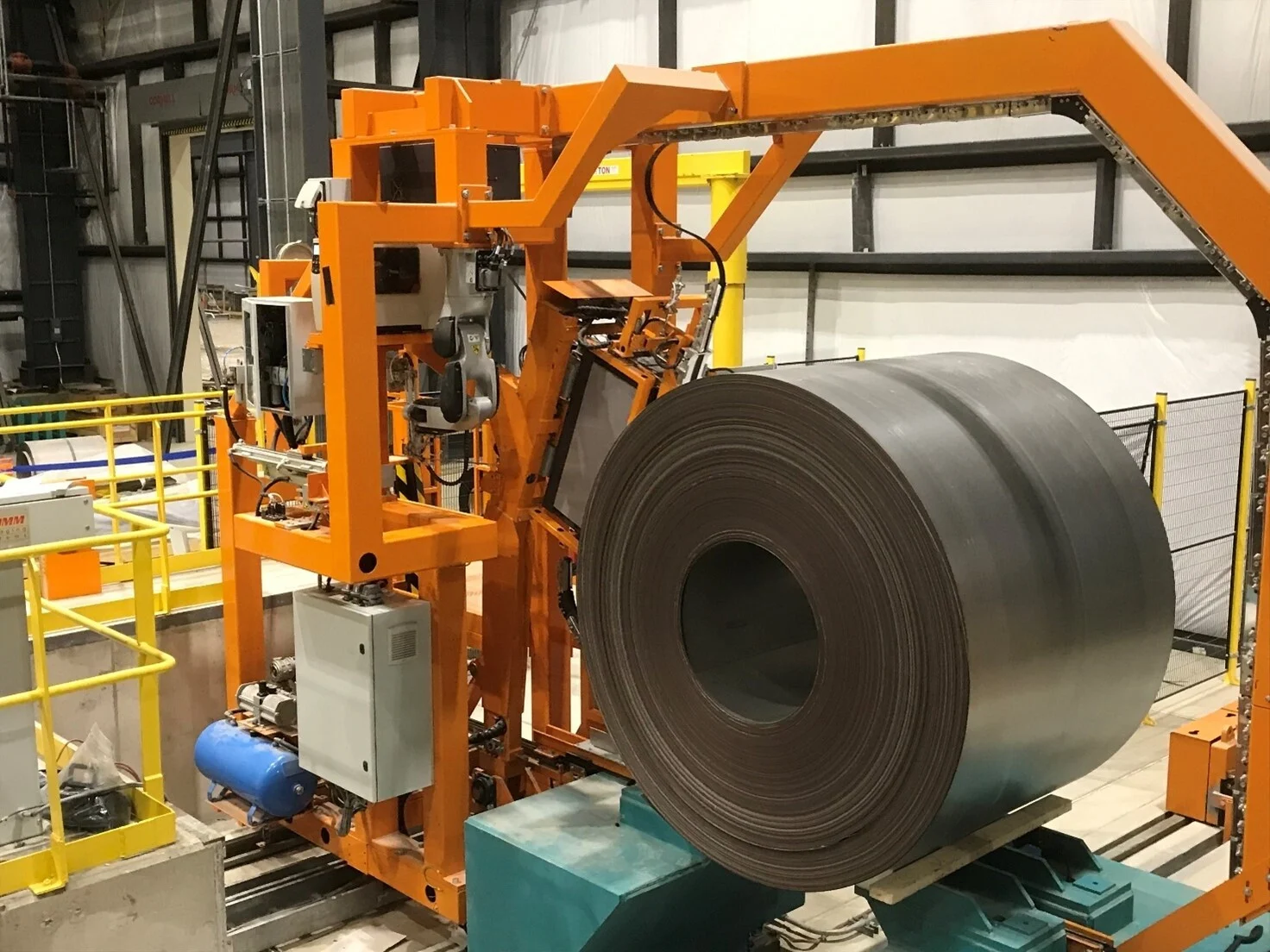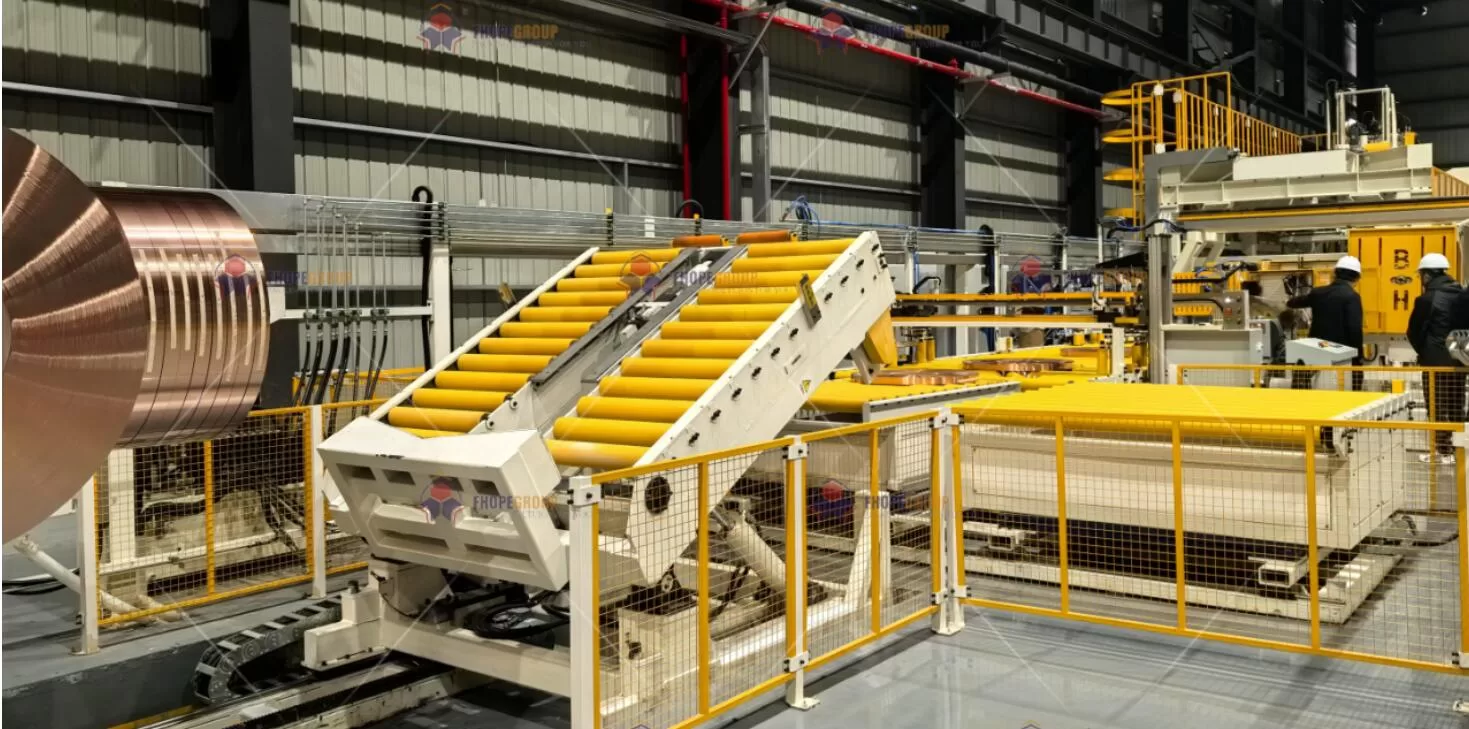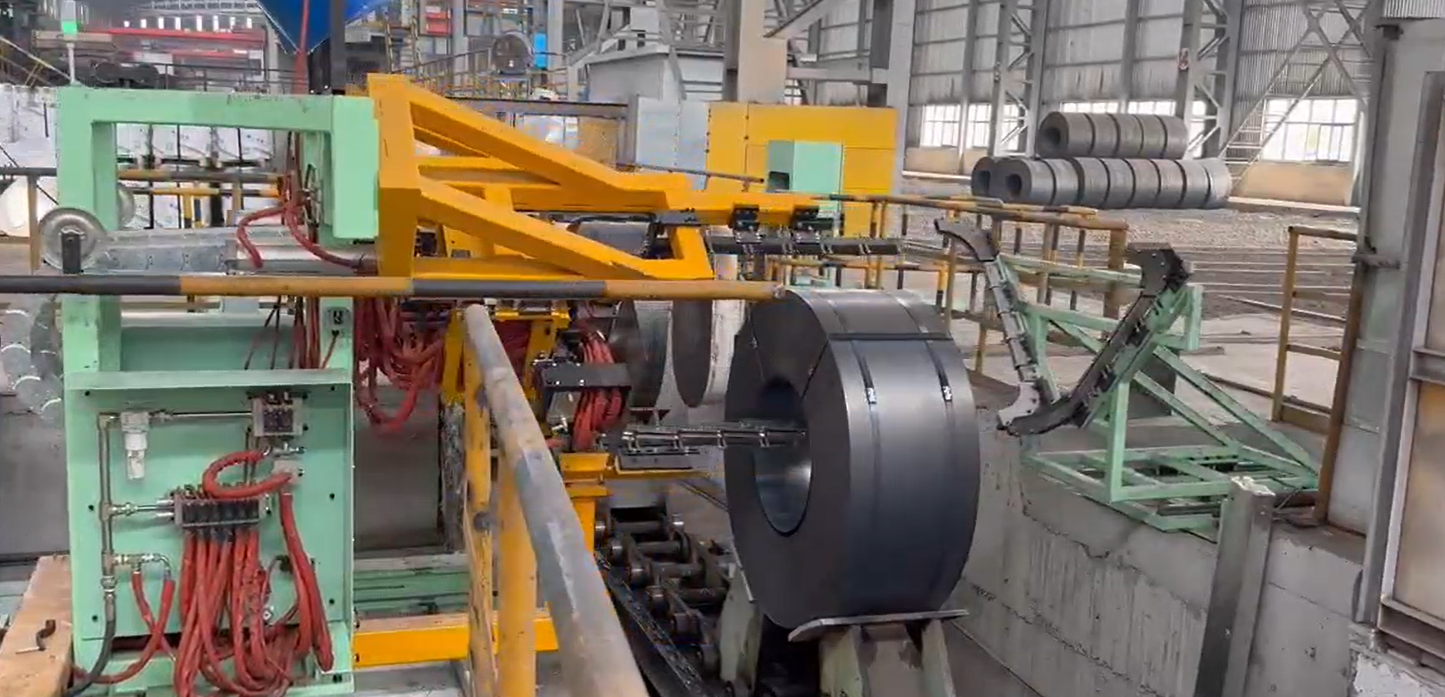How Coil Packing Line for Weigh Checking and Label Printing Revolutionizes Steel Industry Efficiency
Are you tired of inaccurate coil weights, mislabeled products, and inefficient packaging processes slowing down your steel production? Imagine a seamless system where each coil is precisely weighed, accurately labeled, and perfectly prepared for dispatch, all within a single automated line. This isn’t just a dream; it’s the reality of a modern coil packing line equipped with integrated weigh checking and label printing.
A coil packing line with weigh checking and label printing is an automated system designed to streamline the final stages of steel coil production. It ensures accurate weight measurement, applies precise labels for identification and tracking, and efficiently prepares coils for shipping, significantly enhancing operational efficiency and reducing errors in the steel industry. This integrated approach minimizes manual handling, reduces the risk of costly mistakes, and accelerates throughput, providing a significant competitive advantage.
Ready to discover how this technology can transform your steel coil packaging process and boost your bottom line? Let’s delve into the essential components and benefits of these advanced systems.

Coil Weighing: Precision at the Core
Problem: Inaccurate coil weights lead to billing disputes, material waste, and compliance issues. Agitation: Traditional manual weighing methods are prone to human error, time-consuming, and often disrupt the flow of production. Solution: Integrated coil weighing systems within the packing line offer a precise, automated solution, ensuring every coil is accurately measured without slowing down the process.
Coil weighing in a packing line is the critical step of automatically and precisely measuring the weight of each steel coil as it moves through the packaging process. This is achieved using high-precision electronic scales integrated directly into the conveyor system. The system captures weight data in real-time, ensuring accuracy for inventory management, customer billing, and quality control. This eliminates manual weighing stations, reduces bottlenecks, and provides verifiable weight records for every coil processed. The integration of weighing technology directly into the coil packing line is a game-changer for accuracy and efficiency in steel processing.
Dive Deeper into Weighing Accuracy and Efficiency
Accurate weighing is not just about meeting customer expectations; it’s fundamental to operational efficiency and regulatory compliance within the steel industry. Let’s break down why precision weighing is so crucial and how modern coil packing lines achieve it.
The Stakes of Inaccurate Weighing
Inaccurate weight measurements in steel coil processing can trigger a cascade of problems, impacting various aspects of the business.
- Financial Discrepancies: Overcharging or undercharging customers due to incorrect weights leads to billing errors, disputes, and damaged customer relationships.
- Inventory Management Issues: Inaccurate weight data skews inventory records, making it difficult to track stock levels, plan production, and manage raw materials effectively.
- Compliance and Certification Problems: Industries with strict weight regulations (e.g., automotive, aerospace) require precise measurements for quality assurance and legal compliance. Inaccurate weights can lead to rejected batches and hefty fines.
- Material Waste and Loss: Incorrect weight assessments during processing can lead to inefficient material usage, scrap, and financial losses.
- Operational Inefficiencies: Manual weighing processes are time-consuming, labor-intensive, and create bottlenecks in the production line.
How Automated Weighing Solves the Problem
Integrated weighing systems in coil packing lines offer a robust solution to these challenges by providing:
- High Precision Sensors: Advanced electronic load cells deliver highly accurate weight measurements, minimizing errors associated with manual scales.
- Real-time Data Capture: Weight data is captured instantaneously as coils move along the line, eliminating delays and manual recording.
- Seamless System Integration: Weighing scales are seamlessly integrated with the conveyor system and overall line control, ensuring smooth operation and data flow.
- Automated Data Logging: Weight data is automatically recorded and stored in a database, providing a complete and auditable weight history for each coil.
- Reduced Labor Costs: Automation reduces the need for manual weighing and data entry, freeing up personnel for other critical tasks.

Comparing Weighing Methods: Manual vs. Automated
To illustrate the advantages of automated weighing in coil packing lines, let’s compare it to traditional manual methods.
| Feature | Manual Weighing | Automated Weighing (Integrated into Packing Line) |
|---|---|---|
| Accuracy | Prone to human error, lower precision | High precision, minimal error |
| Speed | Slow, bottlenecks in production | Fast, real-time, keeps pace with line speed |
| Labor | Labor-intensive, requires dedicated personnel | Minimal labor, automated operation |
| Data Recording | Manual recording, error-prone, time-consuming | Automatic data logging, accurate and efficient |
| Integration | Standalone process, disrupts production flow | Seamlessly integrated, part of continuous flow |
| Cost Efficiency | Lower initial cost, higher long-term operational costs | Higher initial cost, lower long-term operational costs |
As the table clearly shows, automated weighing within a coil packing line offers significant advantages in terms of accuracy, speed, efficiency, and long-term cost savings, making it a superior choice for modern steel processing facilities.
Label Printing: Traceability and Identification
Problem: Mislabeled coils lead to shipping errors, inventory mix-ups, and customer dissatisfaction. Agitation: Manual labeling is slow, inconsistent, and prone to errors, especially in demanding industrial environments. Solution: Automatic label printing and application within the coil packing line ensure accurate, clear, and durable labels are applied to each coil, guaranteeing traceability and efficient inventory management.
Label printing in a coil packing line is the automated process of generating and applying labels with crucial information to each steel coil after weighing and other processing stages. These labels typically include coil weight, dimensions, production date, customer order details, and barcodes or QR codes for digital tracking. Automatic label printers are integrated into the line to produce labels on-demand, and automated applicators precisely place them on the coils, ensuring consistent and accurate identification throughout the supply chain. This streamlined process eliminates manual labeling errors and provides instant, reliable coil identification.
- Ensuring Clear and Durable Identification
Accurate labeling is paramount for traceability, inventory control, and smooth logistics in the steel industry. Let’s explore the critical aspects of label printing within coil packing lines.
Why Precise Labeling Matters
Effective labeling is not just about sticking a tag on a coil; it’s about creating a robust identification system that impacts numerous operational areas.
- Traceability and Tracking: Labels provide a unique ID for each coil, enabling tracking throughout production, storage, shipping, and delivery. This is crucial for quality control, recall management, and order fulfillment.
- Inventory Management: Clear labels with key information (weight, dimensions, grade) facilitate efficient stock management, reducing errors in picking, storing, and dispatching coils.
- Shipping and Logistics: Accurate labels ensure coils are correctly routed, loaded, and delivered to the right customers, minimizing shipping errors and delays.
- Customer Satisfaction: Correctly labeled coils demonstrate professionalism and accuracy, enhancing customer trust and satisfaction.
- Data Integration: Barcodes and QR codes on labels enable seamless integration with ERP and WMS systems, streamlining data flow and reporting.

Key Features of Automatic Label Printing Systems
Modern coil packing lines utilize sophisticated label printing systems with features designed for industrial demands:
- On-Demand Printing: Labels are printed in real-time, just before application, eliminating the need for pre-printed labels and reducing waste.
- Variable Data Printing: Systems can print variable information such as weight, batch numbers, dates, and customer-specific details on each label.
- High-Resolution Printing: Printers produce clear, legible text, barcodes, and graphics, ensuring readability in industrial environments.
- Durable Label Materials: Labels are made from robust materials resistant to tearing, moisture, temperature variations, and abrasion, ensuring longevity and readability.
- Automated Application: Applicators precisely and consistently place labels on coils, regardless of size or shape, ensuring secure adhesion and correct positioning.
Labeling Technologies: Inkjet vs. Thermal Transfer
Two primary technologies are commonly used in coil packing line label printing: Inkjet and Thermal Transfer. Each offers distinct advantages and is suited for different applications.
| Feature | Inkjet Printing | Thermal Transfer Printing |
|---|---|---|
| Print Quality | High resolution, suitable for graphics and text | Very high resolution, excellent for barcodes and text |
| Durability | Good, but may require protective coatings | Excellent, highly resistant to smudging and abrasion |
| Media Versatility | Wide range, including paper, films, and direct-to-product | Limited to coated label stocks and some films |
| Speed | High speed, ideal for high-volume applications | Moderate speed, suitable for medium to high volumes |
| Cost per Label | Lower, especially for high volumes | Higher, due to ribbon requirement |
| Maintenance | More complex, printhead maintenance required | Simpler, less maintenance needed |
| Best Suited For | Variable data, large characters, some graphics | Barcodes, small text, durable labels |
Choosing between inkjet and thermal transfer depends on specific requirements like label durability, print detail, volume, and budget. Often, thermal transfer is preferred for critical tracking labels in steel coil packing due to its superior durability and barcode clarity.
Integrated Weigh Checking and Labeling Systems: The Synergy of Automation
Problem: Disjointed weighing and labeling processes create bottlenecks and increase the risk of errors. Agitation: Manually transferring weight data to labeling systems is inefficient and error-prone, requiring extra steps and labor. Solution: Integrated systems combine weigh checking and label printing into a single seamless operation, eliminating manual data entry, improving accuracy, and accelerating the entire packaging process.
Integrated weigh checking and labeling systems represent the pinnacle of efficiency in coil packing lines. These systems combine the functions of precise weighing and accurate label printing into a single, synchronized operation. As coils are weighed, the weight data is automatically transferred to the label printer, which generates a label with the weight and other relevant information. This label is then automatically applied to the coil, all without manual intervention. This integration eliminates data entry errors, speeds up processing, and ensures complete data consistency from weighing to labeling. This seamless flow maximizes throughput and minimizes the potential for mistakes in critical coil information.
Benefits of Automated Coil Packing Lines with Weigh Checking and Label Printing

Automated coil packing lines with integrated weigh checking and label printing deliver a multitude of benefits, including increased efficiency, improved accuracy, reduced labor costs, enhanced traceability, and greater customer satisfaction. These advantages translate directly into a stronger bottom line and a more competitive operation for steel manufacturers. By automating these critical processes, businesses can optimize their entire coil handling and packaging workflow.
Beyond the core functionalities of weighing and labeling, automated coil packing lines offer a comprehensive suite of advantages that significantly impact overall operational performance.
- Enhanced Efficiency and Throughput: Automation dramatically speeds up the packaging process. Integrated systems eliminate manual handling and data entry, allowing for continuous, high-speed operation and increased throughput.
- Improved Accuracy and Reduced Errors: Automated weighing and labeling minimize human error, ensuring precise weight measurements and accurate label information. This reduces costly mistakes, rework, and customer disputes.
- Reduced Labor Costs: Automation reduces the need for manual labor in weighing, labeling, and data recording. This frees up personnel for more value-added tasks and lowers overall labor expenses.
- Enhanced Traceability and Inventory Control: Accurate weight and label data provide real-time visibility into inventory levels and coil locations. This improves traceability throughout the supply chain, simplifies stock management, and reduces losses due to misplacement or errors.
- Consistent Packaging Quality: Automated systems ensure consistent and repeatable packaging processes. Every coil is weighed, labeled, and prepared to the same high standards, enhancing product presentation and customer confidence.
- Improved Safety: Automation reduces manual handling of heavy coils, minimizing the risk of workplace injuries and creating a safer working environment.
- Data Integration and Reporting: Integrated systems seamlessly interface with ERP, WMS, and other business systems, providing valuable data for performance monitoring, quality control, and process optimization.
- Scalability and Flexibility: Automated lines can be easily scaled to meet changing production demands. Modular designs and flexible configurations allow for customization to specific coil sizes, packaging requirements, and facility layouts.
- Faster ROI: While the initial investment in automation may be higher, the long-term benefits of increased efficiency, reduced costs, and improved quality lead to a faster return on investment and greater profitability.
- Increased Customer Satisfaction: Accurate weights, clear labeling, and efficient order fulfillment contribute to higher customer satisfaction and stronger customer relationships.
Conclusion
Investing in a coil packing line with integrated weigh checking and label printing is a strategic move for steel manufacturers seeking to optimize their operations, enhance product quality, and gain a competitive edge. The precision, efficiency, and data-driven capabilities of these systems deliver significant and measurable improvements across the entire coil packaging workflow, paving the way for greater profitability and long-term success in the demanding steel industry.









